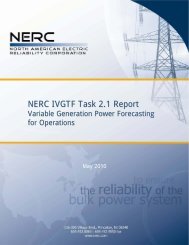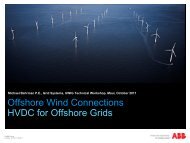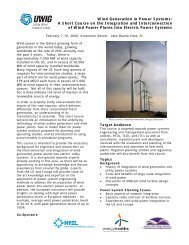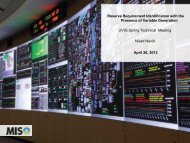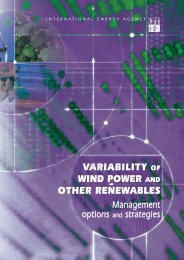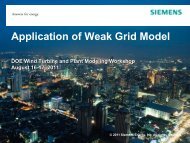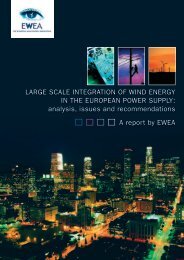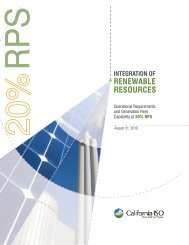Integrating Southwest Power Pool Wind to Southeast Electricity ...
Integrating Southwest Power Pool Wind to Southeast Electricity ...
Integrating Southwest Power Pool Wind to Southeast Electricity ...
Create successful ePaper yourself
Turn your PDF publications into a flip-book with our unique Google optimized e-Paper software.
is consistent with balancing costs seen in other wind integration studies, if somewhat on the low<br />
side.<br />
Table 5-12: Difference** in average generation for Scenario 1 vs. Scenario 1 Proxy<br />
Change in<br />
GW EES TVA SoCo SPP SERC W SERC E Total<br />
CC (0.03) (0.04) (0.09) (0.93) 0.02 0.03 (1.05)<br />
GT (0.00) 0.01 (0.02) (0.38) 0.02 0.03 (0.34)<br />
Hydro - (0.00) 0.00 - - 0.00 (0.00)<br />
Nuclear 0.00 - - 0.00 - 0.00 0.00<br />
Steam<br />
Coal<br />
0.02 0.08 0.12 0.82 0.24 0.15 1.42<br />
GasOil (0.03) - (0.00) (0.01) - 0.00 (0.04)<br />
<strong>Wind</strong> - - - - - - -<br />
Other 0.00 0.00 0.01 (0.02) 0.00 0.02 0.01<br />
Total (0.04) 0.04 0.02 (0.53) 0.29 0.22 (0.00)<br />
**Positive value represents increase in generation in Scenario #1 Proxy relative <strong>to</strong> Scenario #1.<br />
Reserve Requirements and Provision<br />
One of the significant differences in each of the High <strong>Wind</strong> Transfer scenarios is how reserves<br />
are carried across the footprint. The changes in reserve requirements for each scenario are<br />
presented in Chapter 3. This section examines how those reserves are provided in each of the<br />
scenarios. Regulation up requirements and spinning reserve requirements were seen <strong>to</strong> be the<br />
significant, and are examined here, <strong>to</strong>gether with <strong>to</strong>tal reserve requirements.<br />
Regulation Up<br />
The analysis of reserve requirements presented in Chapter 3 show that moving <strong>to</strong> larger areas<br />
decreased regulation requirements, from an average of 2.2 GW in Scenario 1 <strong>to</strong> 2.1 GW in<br />
Scenario 2 <strong>to</strong> 1.9 GW in Scenarios 3 and 4. Figure 5-13 shows the average allocation of<br />
regulating up reserve by unit type for each of the scenarios. The first conclusion from this is the<br />
importance of CC units <strong>to</strong> providing the regulating reserve needed, especially considering the<br />
earlier point that some of these CCs may not be built if 48 GW of wind were <strong>to</strong> be installed.<br />
Hydro units are also shown <strong>to</strong> be important, however, these are probably going <strong>to</strong> remain in<br />
operation. Coal units provide less regulation in Scenario 3 as they provide more energy with the<br />
reduced reserve requirements resulting in fewer online CCs. It can be seen that GTs are needed<br />
in Scenario 2 <strong>to</strong> provide regulation offsetting some of the benefits of moving Scenario 1<br />
regulation from SPP <strong>to</strong> other regions.<br />
5-20




